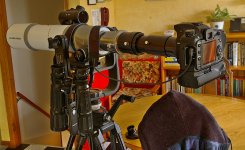Ultralite - are you sure about IS kicking in so late?
Ultralite:
No I'm not sure. I'm just passing on what I remember reading over in the Pentax forum. You might want to ask this question over there they seem to know everything Pentax:
http://www.pentaxforums.com/forums/
I had a good conversation with a Pentax tech out in Colorado. What he said made a lot of sense. The Pentax IS was made to compensate for the slow deep motion of a hand-held camera. When a camera is on a tripod the motion is more in the nature of a vibration that is fast and shallow so it's better just to turn it off.
In any case I use a Bogen 3246 tripod with a Bogen 3421 fork mount and it works well for me. I even put a 120mm (objective size) 1000mm fl astro scope on it for photography and it worked. Definitely at the mounts limits but ok. Get the right plate, fine tune the clutch resistance and balance and it gets the job done. For me speed is essential so I like to keep my hands on the camera and not think about what the mount is doing - just pan and tilt with my eye to viewfinder with both hands on the camera. It works for me.
Btw, which body provides focus confirmation with the scope - your Pentax 20D? That would be a great feature to have... unfortunately, Kwanon only provides focus confirmation with EF lenses.
Ultralite:
The K20D.
Paul Mentioned not being being too impressed with his old Samsung but I think the K20D is a much more refined camera than one from the old *ist days. It works with any lens I put on it so far. Of course sometimes there just is not enough light for it to work but not often. After all sometimes there is not enough light to even focus manually.
As far as cameras goes, my shortlist is down to the following:
- Build-in IS
- Live view
- Focus confirmation with the scope
Anyone know of any bodies which provide these - especially #3?
Ultralite:
The Pentax K20D has all these features.
I don't use IS or live view however.
Cheers,
Vandit




